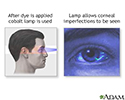Fluorescein eye stain
This is a test that uses orange dye (fluorescein) and a blue light to detect foreign bodies in the eye. This test can also detect damage to the cornea. The cornea is the outer surface of the eye.
How the Test is Performed
A piece of blotting paper containing the dye is touched to the surface of your eye. You are asked to blink. Blinking spreads the dye and coats the tear film covering the surface of the cornea. The tear film contains water, oil, and mucus to protect and lubricate the eye.
The health care provider then shines a blue light at your eye. Any problems on the surface of the cornea will be stained by the dye and appear green under the blue light.
The provider can determine the location and likely cause of the cornea problem depending on the size, location, and shape of the staining.
How to Prepare for the Test
You will need to remove your eyeglasses or contact lenses before the test.
How the Test will Feel
If your eyes are very dry, the blotting paper may be slightly scratchy. The dye may cause a mild and brief stinging sensation.
Why the Test is Performed
This test is to:
- Find scratches or other problems with the surface of the cornea
- Reveal foreign bodies on the eye surface
- Determine if there is irritation of the cornea after contacts are prescribed
Normal Results
If the test result is normal, the dye remains in the tear film on the surface of the eye and does not stick to the eye itself.
What Abnormal Results Mean
Abnormal results may point to:
- Abnormal tear production (dry eye)
-
Blocked tear duct
Blocked tear duct
A blocked tear duct is a partial or complete blockage in the pathway that carries tears from the surface of the eye into the nose.
 ImageRead Article Now Book Mark Article
ImageRead Article Now Book Mark Article -
Corneal abrasion
(a scratch on the surface of the cornea)
Corneal abrasion
Corneal injury is a wound to the part of the eye known as the cornea. The cornea is the crystal clear (transparent) tissue that covers the front of ...
 ImageRead Article Now Book Mark Article
ImageRead Article Now Book Mark Article -
Foreign bodies, such as eyelashes or dust (
eye - foreign object in
)
Eye - foreign object in
Click the icon to watch an animation about blinking. The eye will often flush out small objects, like eyelashes and sand, through blinking and teari...
 ImageRead Article Now Book Mark Article
ImageRead Article Now Book Mark Article - Infection
- Injury or trauma
- Severe dry eye associated with arthritis (keratoconjunctivitis sicca)
Risks
If the dye touches the skin, there may be a slight, brief, discoloration.
References
Prokopich CL, Hrynchak P, Elliott DB, Glanagan JG. Ocular health assessment. In: Elliott DB, ed. Clinical Procedures in Primary Eye Care . 4th ed. Philadelphia, PA: Elsevier; 2014:chap 7.
-
Fluorescent eye test - illustration
The fluorescent eye test is useful in determining if there is a scratch or other problem with the surface of the cornea. It can also be used to detect foreign bodies on the surface of the eye, and determine if there is an injury to the eye or eye infection. The test is performed by administering dye onto the eye's surface. After the dye has thoroughly covered the eye a cobalt blue light is then directed on the eye. The light causes the dye to glow green. Abnormalities in the corneal epithelium will cause the dye to stain that region.
Fluorescent eye test
illustration
-
Fluorescent eye test - illustration
The fluorescent eye test is useful in determining if there is a scratch or other problem with the surface of the cornea. It can also be used to detect foreign bodies on the surface of the eye, and determine if there is an injury to the eye or eye infection. The test is performed by administering dye onto the eye's surface. After the dye has thoroughly covered the eye a cobalt blue light is then directed on the eye. The light causes the dye to glow green. Abnormalities in the corneal epithelium will cause the dye to stain that region.
Fluorescent eye test
illustration
Review Date: 1/31/2015
Reviewed By: Linda J. Vorvick, MD, Medical Director and Director of Didactic Curriculum, MEDEX Northwest Division of Physician Assistant Studies, Department of Family Medicine, UW Medicine, School of Medicine, University of Washington, Seattle, WA. Also reviewed by David Zieve, MD, MHA, Isla Ogilvie, PhD, and the A.D.A.M. Editorial team.

